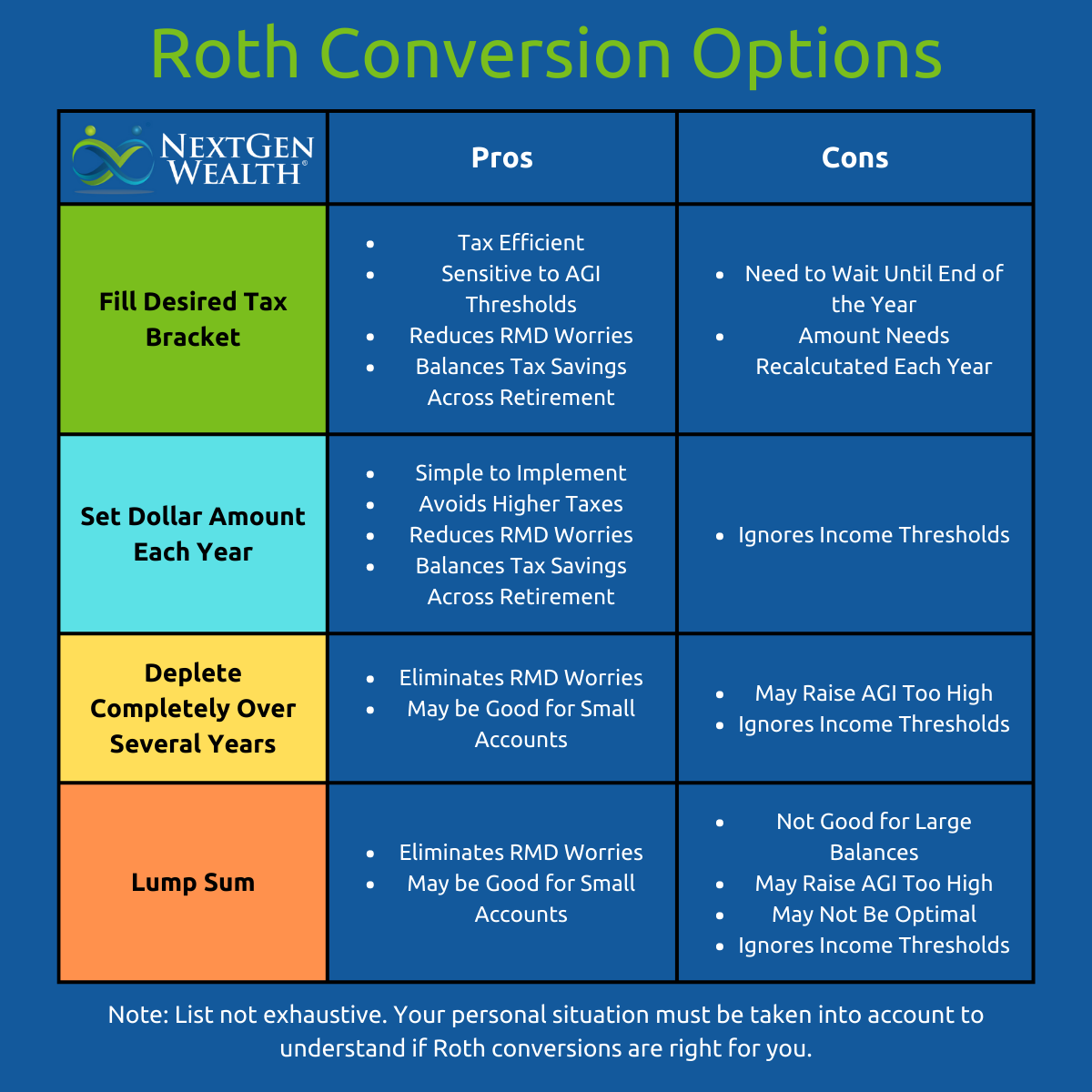Calculating the Right Amount of Roth Conversions

Roth conversions are one of the most powerful methods for maximizing long-term tax savings. If you believe that a Roth conversion might be something you could benefit from, the next question is how much to convert. The right amount will vary based on your situation.
Once you’ve decided to implement a Roth conversion strategy, you’ll want to look at areas of opportunity. We usually look at projected cash flows throughout retirement and attempt to find any dips in income. Dips in income may be opportunities for additional Roth conversions.
Why Roth Conversions are Helpful
Roth conversions can be a helpful tool to maximize your tax savings over your lifetime while avoiding other issues later.
Reduce Overall Tax Bill
There is a tradeoff between paying taxes now and paying taxes later. Regardless, your income from your traditional retirement accounts like your 401k or IRA will be taxed at some point. By completing Roth conversions, you pay the taxes upon conversion now, but then you can enjoy tax-free growth and tax-free income later.
This can lead to substantially lower taxes over your total lifetime. Once you convert your retirement account balance to Roth, it will continue to grow tax free. This means you pay now while the balance is lower so you can avoid paying even more taxes when your balance is higher and you’re forced to pull money out for required minimum distributions.
Avoid RMDs
Required Minimum Distributions (RMDs) force you to withdraw money from your traditional retirement accounts or face a penalty from the IRS. This can force you to withdraw more than you want. Technically you can reinvest this amount, but you’ll still have to recognize the income on your taxes.
Roth IRAs are not subject to RMDs, so you can avoid taking RMDs completely for anything you convert.
Tax Efficiency for Surviving Spouse and Heirs
Another benefit to converting your IRA or 401k to a Roth IRA is the beneficial tax treatment for your surviving spouse or other heirs.
Surviving Spouse
If your spouse inherits a qualified retirement account like a 401k or a traditional IRA, then withdrawals will still be taxed as ordinary income. Although your spouse can file as a surviving spouse for a short period after your passing, they will eventually have to file as single (unless they remarry).
This means they would have a smaller standard deduction and they would be subject to lower thresholds for the higher tax brackets – everything is basically cut in half. So, if your surviving spouse takes the required RMDs for that account, they may end up paying significantly more in taxes.
Heirs
The same concept applies for other heirs such as children. It’s also important to understand your children may be doing okay financially and have their own RMDs to contend with. Additional taxable income, coming from the IRA they inherit from you, may cause a tax burden you didn’t intend to give them.
If they had inherited a Roth IRA instead, those withdrawals would not be taxed. This avoids passing a tax headache on to your spouse or other heirs.
Different Methods to Implement Roth Conversions
If you’ve decided a Roth conversion strategy would be good for your situation, you still need to look at the details of how much to convert and when. There are several different options including:
- Lump Sum
- Deplete Completely Over Several Years
- Set Amount per Year
- Fill a Particular Tax Bracket
Let’s discuss how these are completed and the pros and cons of each. We’ll also check out these scenarios following our good friends Max and Minny Benny. They have $1,500,000 in Max’s 401k to possibly convert to Roth.

Lump Sum
Technically, you could convert your entire account balance to Roth. Taking a lump sum is almost always going to be the least favorable option.
Unless you have a relatively small balance to convert, you’ll lose way too much to taxes. We’re not saying to totally dismiss this as an option, but you should be careful to avoid paying too much in taxes. If Max and Minny implemented this strategy, they’d end up with $3,347,569 less over their lifetime while paying $280,158 less in taxes– not exactly what we were hoping for.
Deplete Completely Over Several Years
Like the lump sum, you’d be converting the entire account balance to Roth except this time it would be over several years. Max and Minny have a window of 8 years between when they retire and when they start drawing Social Security at age 70 to complete the conversions.
They’ll end up converting the whole 401k balance over 8 years. All said and done when this strategy is implemented, they’ll end up with $402,160 more total lifetime assets. Their total tax savings would be an estimated $602,628. That’s a pretty nice outcome overall!
Set Amount per Year
After discussing everything with Max and Minny, they don’t really want to convert everything to Roth. They can convert a good portion now and then utilize the remaining balance to fund retirement. Plus, they just really can’t stand the idea of paying all those taxes up front.
They’re comfortable with converting about $50,000 per year until it’s time to start drawing Social Security. If they do this, they’ll convert $400,000 to Roth in 8 years. This increases their final projected assets by $2,641,234 and saves them $235,999 in taxes - now we’re starting to get somewhere!
Just to see, if they convert $50,000 each year for a total of 13 years (when they’ll start their RMDs), they actually have a much better result with a lifetime portfolio value gain of $2,996,164 and additional tax savings of $274,639.
If Max and Minny continued to complete $50,000 of Roth conversions after the 13 year mark when they start RMDs, they get a worse outcome. They would not want to continue conversions after this point.
Fill a Particular Tax Bracket
The final option we’ll discuss is “filling” a particular tax bracket each year. In other words, we look at the income for the year and then convert as much as we can without raising your income above higher tax bracket thresholds.
The nice part about this strategy is it’s specific to your needs and focuses on tax efficiency. We’re not going to raise your annual income too high, but we’ll be making meaningful progress toward converting traditional accounts to Roth.
When looking at Max and Minny’s situation, we can plan to fill the 12% tax bracket starting at retirement and continuing until they start drawing Social Security at age 70. This results in an additional $3,204,077 in their lifetime – even better! They’ll also save an estimated $269,015 in taxes overall!
You might be wondering why Max and Minny would fill the 12% tax bracket and not the 22% or 24% brackets. The answer is simple, converting more at higher tax brackets is a lot less effective. Think about it this way, converting within the 12% bracket is like a discount on taxes compared to converting at the 22% tax bracket.
Just for comparison, simply changing the strategy to fill to 22% bracket results in $858,075 more portfolio value (versus $3,204,077 for the 12%). Interestingly, this results in $590,678 less in taxes over Max and Minny’s lifetime. Would the extra tax savings be worth a difference in $2,346,002? Probably not.
Filling the 12% tax bracket with Roth conversions until the year before RMDs start is going to yield the best results for Max and Minny.
How Much Do You Really Need to Convert?
Even after looking at all these different methods to implement a Roth conversion strategy, you might not need to convert as much as possible. A good goal is to convert enough to Roth so your RMDs will be about the amount you plan to withdraw in retirement anyway. You have to remember there’s a balance between paying taxes now and paying taxes later.
There’s no need to get super aggressive with Roth conversions if it’s not really needed. Just like a healthy diet, we want balance and moderation.
Risks of Roth Conversions
It’s not always going to be best to complete Roth conversions. There are several reasons why skipping Roth conversions for a year or two, or limiting how much you convert, would be beneficial.
Converting too Late in Life
The advantage of Roth conversions diminishes as time goes on. When you convert your 401k to a Roth IRA, you’re paying taxes now so you can avoid RMDs and/or have tax-free income later. If you convert too late, you’ll pay the taxes, but won’t recoup that tax money through growth of your Roth IRA.
Depending on your circumstances, it might still make sense to complete some Roth conversions throughout retirement.
Making AGI too High
You’ll want to be very careful not to convert too much in any given year. Roth conversions are counted as taxable income in the year you convert, so your Adjusted Gross Income (AGI) will increase. This can push you over other important thresholds.
The most noticeable threshold you need to be considerate of is the Income Related Monthly Adjustment Amounts (IRMAA) for your Medicare premiums. If your Modified Adjusted Gross Income (MAGI) is too high, you’ll be charged higher Part B and Part D Medicare premiums. These adjustments start at $97,001 (Filing Single) or $194,001 (Married filing Jointly) (based on 2021 income).
It’s also really important to remember IRMAAs are calculated based on your MAGI from two years previous. This means any conversions you complete starting when you’re 63 could affect your Medicare premiums.
College Planning
If you still have children in college, Roth conversions could also affect your child’s eligibility for student aid. Higher income levels increase the Expected Family Contribution (EFC) used for student aid applications. This is going to vary by family and the child’s college they choose to go to as well.
Proper Timing of Roth Conversions
We touched on this some already, but proper timing of Roth conversions is important. There’s generally a window of opportunity between when you retire and when you start drawing Social Security or even up until you start RMDs to complete Roth conversions. However, this might not be the most optimal time depending on your preparedness for retirement and other life circumstances.
This makes planning your transition into retirement even more critical. There’s already a lot of changes happening, so adding additional work isn’t always what you want. Plus, making a mistake with your nest egg can be painful.
How NextGen Wealth Helps with Roth Conversions
At NextGen Wealth, we specialize in the transition into retirement. We work extensively with clients in the five years before retirement and then throughout retirement. Roth conversions are something we handle on a regular basis.
In practice, we use software to create a detailed plan of how we want to complete Roth conversions. However, we calculate how much each year and then complete conversions. We take great care to make sure we’re deliberate and precise when implementing a Roth conversion strategy.
Not only do we help decide if Roth conversions are right for you, but we also help complete Roth conversions too. We take the time to check over your financial situation to decide how much and when to convert. Think of us as your guide on a tax-saving journey through retirement.


